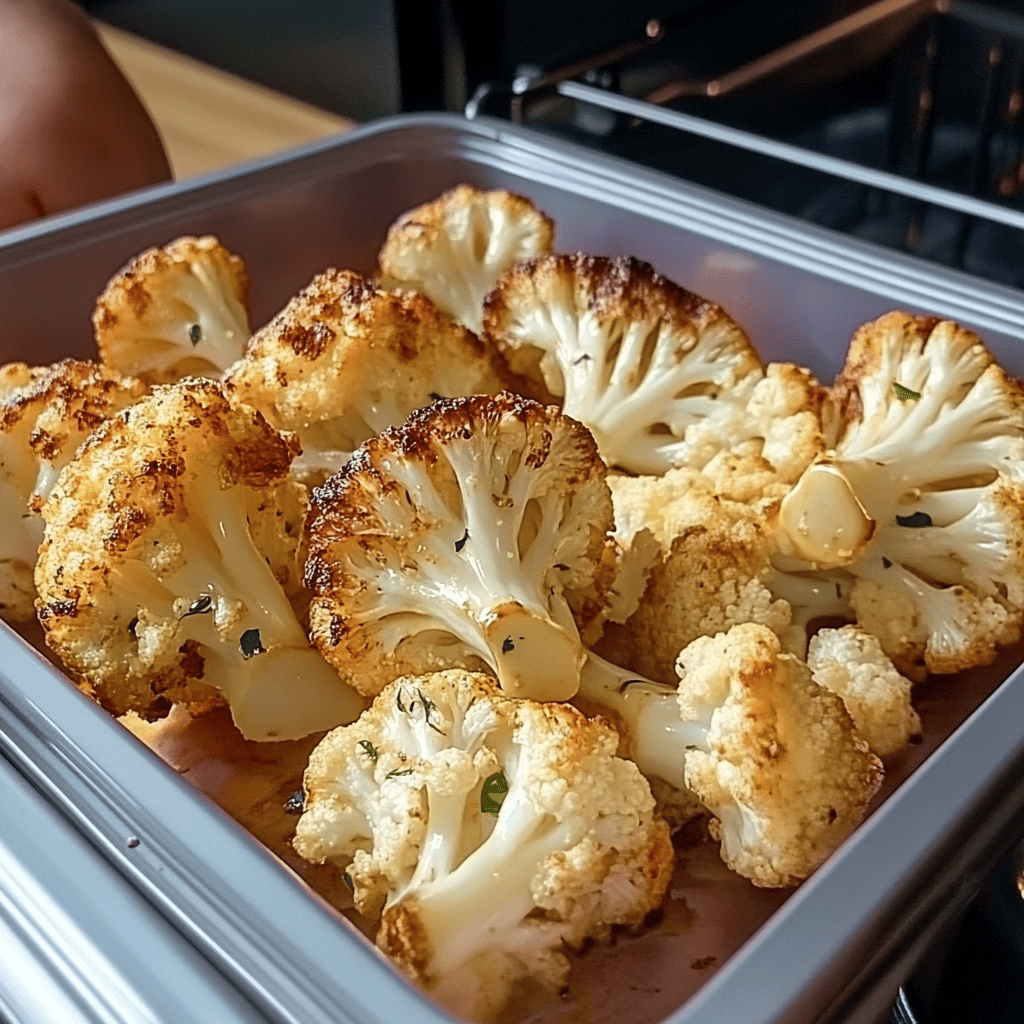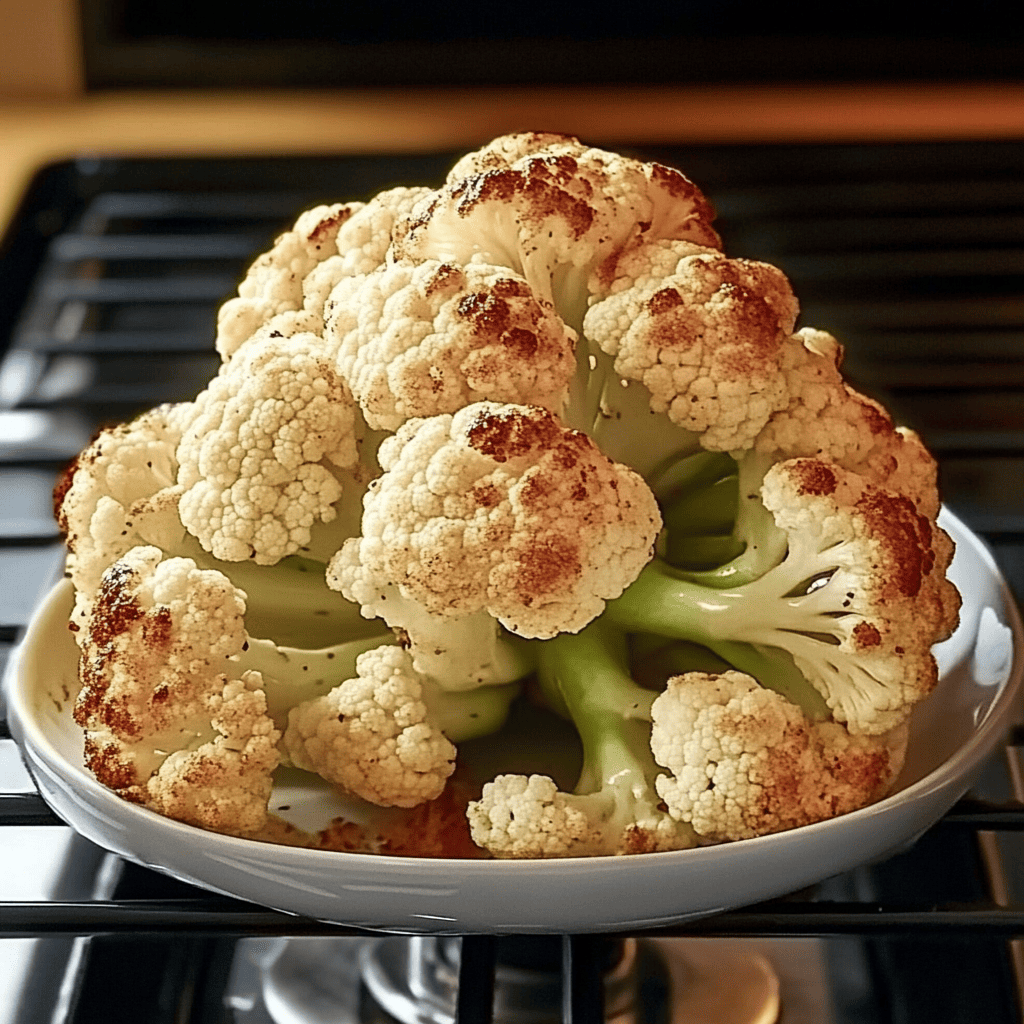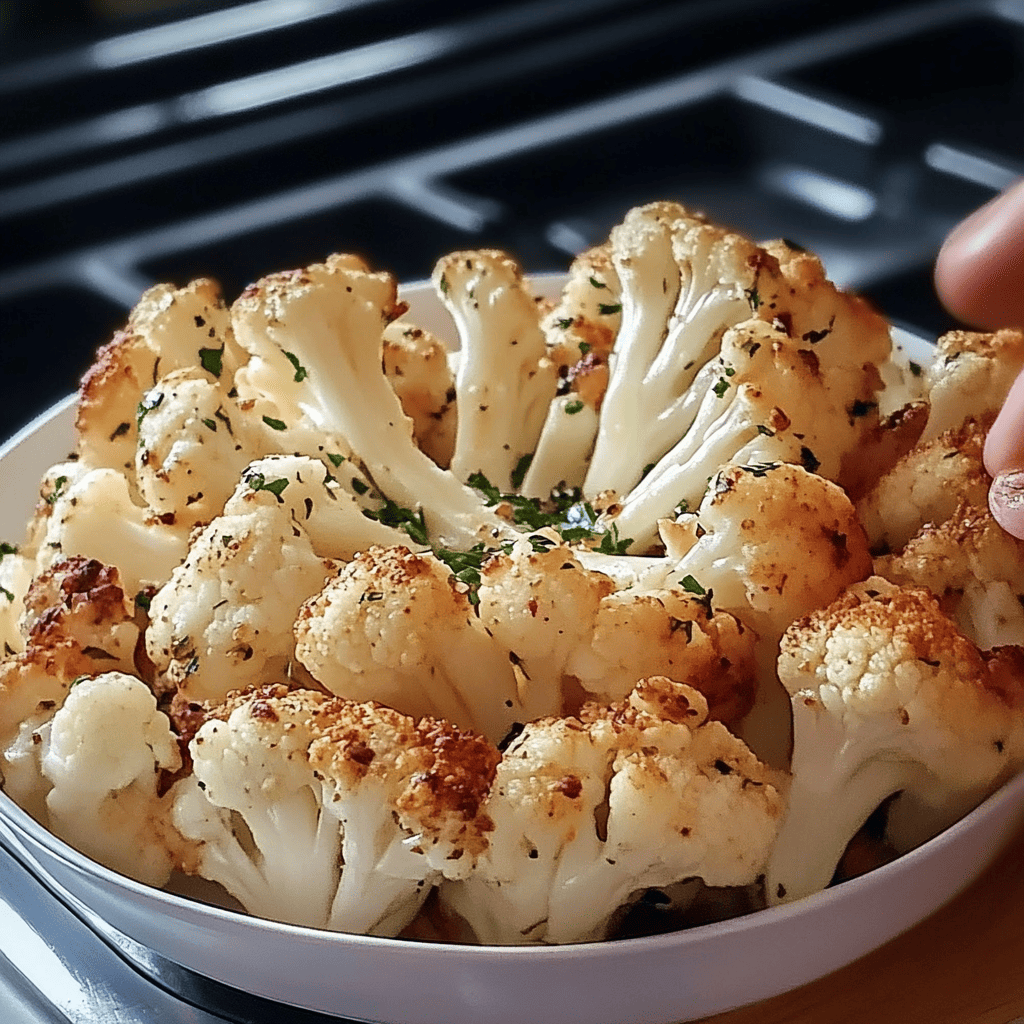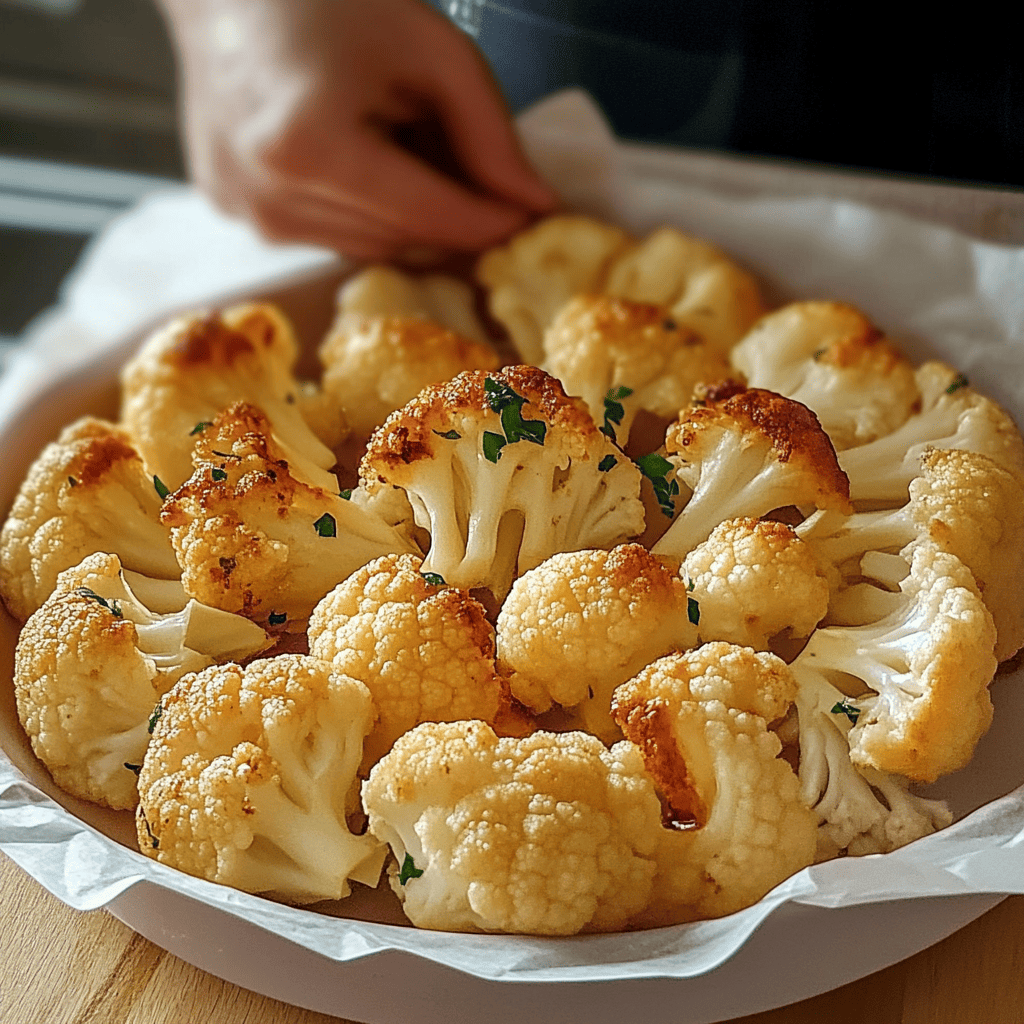Roasted Cauliflower: From Side Dish to Culinary Star
Introduction: A Golden and Tasty Transformation
Roasted Cauliflower has gone from being a vegetable often relegated to the background to becoming a culinary star in its own right. This preparation highlights cauliflower’s versatility, transforming its florets into bite-sized pieces that are tender on the inside and deliciously caramelized and slightly crunchy on the outside. The roasting process not only enhances its natural flavor but also gives it an irresistible texture and aroma. It’s a perfect side dish, a healthy appetizer, or even the basis of a light and nutritious vegetarian dish. The image perfectly captures the golden texture and visual appeal of this simple yet deeply satisfying dish. Discover all the secrets of this preparation that you’ll love for its simplicity and delicious results!
Detailed History in Spanish: From the Mediterranean to the Global Table
The history of cauliflower in gastronomy is as rich as its flavor when prepared correctly. Its transformation from a “boring” vegetable to a star ingredient is a testament to the evolution of culinary trends and the appreciation of plant-based cooking.
Ancient Origins in the Mediterranean: Cauliflower, like broccoli, cabbage, and Brussels sprouts, belongs to the Brassica family (Brassica oleracea). Its origins are believed to date back to the Mediterranean region, where wild varieties were cultivated more than two thousand years ago. The Romans were already familiar with and consumed a rudimentary form of cauliflower.
Expansion throughout Europe: During the Middle Ages, cauliflower spread throughout the Middle East and North Africa. It wasn’t until the 16th century that it gained popularity in Europe, particularly in Italy and France, where it was adopted by the nobility. Catherine de Medici, for example, is said to have introduced it to the French court. From the 17th century onward, its cultivation became more common in England and the rest of Europe.
Roasting Technique: A Timeless Classic: Roasting is one of the oldest and most universal cooking techniques. Cooking vegetables (or meats) in an oven or over direct heat to caramelize their natural sugars and develop complex flavors is an ancient culinary practice. However, cauliflower was traditionally boiled or steamed, often resulting in a mushy texture and a strong odor that wasn’t to everyone’s taste.
The Renaissance of Cauliflower in Modern Cooking: In recent decades, there has been a resurgence of interest in vegetables and an exploration of new ways to prepare them to enhance their flavor and texture. Roasting has been key to this revolution. Roasting cauliflower produces the “Maillard reaction” (which also occurs in browning), creating umami flavors and a slightly crispy, sweet exterior, while keeping the interior tender. This eliminates the sulfurous odor sometimes associated with boiled cauliflower.
Influence of Plant-Based and Low-Carb Diets: The growing popularity of vegetarian, vegan, gluten-free, and low-carb diets (like keto) has catapulted cauliflower to stardom. It has become a versatile substitute for grains (cauliflower rice), doughs (cauliflower pizza crust), and other starches, and roasting it is one of the most delicious ways to enjoy it in its natural form.
The Air Fryer and Convenience: The popularity of appliances like the air fryer has made preparing roasted cauliflower even easier, allowing for a crispy, fried-like result with less oil and in less time, contributing to its popularity in home kitchens.
In short, “Roasted Cauliflower” is a dish that encapsulates a culinary evolution: from a humble vegetable to a versatile and delicious ingredient, valued for its flavor, texture, and the benefits it brings to modern diets. It’s a perfect example of how a simple cooking technique can transform an ingredient.
More Historical Detail: The Chemistry of Flavor and Plant Versatility
Delving a little deeper into the history and cultural significance of “Roasted Cauliflower,” we can highlight:
- The Maillard Reaction: As mentioned, this dish is an excellent example of the Maillard reaction in action. This chemical reaction, which occurs when sugars and amino acids react under heat, is responsible for the browning, caramelization, and complex, rich flavors (umami) that develop on the surface of the cauliflower as it roasts. It’s what transforms a pale floret into a golden, savory morsel.
- Root to Flower Use: Historically, many cultures have valued the complete utilization of vegetables. In the case of cauliflower, not only the florets are edible; the tenderest leaves and the central stem can also be roasted, sautéed, or used in broths and purées, promoting “zero-waste” cooking.
- Innovation in Dressings and Sauces: The simplicity of roasted cauliflower makes it a perfect canvas for a variety of dressings and sauces. The image shows a creamy, light orange sauce, which could be a spiced mayonnaise, a paprika-yogurt sauce, or a lemon-tahini sauce. This versatility in pairing with different flavor profiles (from Asian to Mediterranean, spicy to tangy) has contributed to its widespread acceptance.
- Cauliflower as a Base for Vegetarian and Vegan Dishes: More than just a side dish, roasted cauliflower has been ingeniously used as a main course in vegetarian and vegan cuisine. From roasted cauliflower steaks to roasted cauliflower in curries, the roasting technique gives it a substance and body that make it a satisfying component of a meal.
- The Rise of “Star Vegetables”: In recent years, we’ve seen certain vegetables go from mere side dishes to starring roles in haute cuisine restaurants and culinary publications. Cauliflower, along with broccoli, Brussels sprouts, and carrots, has benefited greatly from this trend, being prepared in creative ways previously reserved for meats.
“Roasted Cauliflower” is a testament to the creativity of vegetable cooking, proving that with the right technique and a little imagination, an ordinary vegetable can be transformed into an exceptional culinary experience.

Ingredients & Detailed Preparation
Ingredients (for roasted cauliflower):
- Fresh cauliflower: 1 large head (approximately 1 kg)
- Extra virgin olive oil: 2-3 tablespoons
- Sea or kosher salt: To taste
- Freshly ground black pepper: To taste
- Optional: Garlic powder or onion powder: ½ teaspoon (for extra flavor)
- Optional: Sweet or smoked paprika: ½ teaspoon (for color and flavor)
- Optional: Chopped fresh herbs (chives, parsley, oregano, thyme): 1 tablespoon for garnish
Ingredients (for a simple side sauce like the one pictured):
- Mayonnaise: ½ cup
- Sriracha or hot sauce: 1-2 teaspoons (adjust to taste)
- Lemon juice: 1 teaspoon
- Sweet or smoked paprika: ½ teaspoon
- Salt and pepper: To taste
Necessary equipment:
- Cutting board and large knife
- Large baking tray (with baking paper if desired for easy cleaning)
- Large mixing bowl
- Tweezers or spatula
- Small bowl for sauce
Detailed Preparation:
A. Prepare the Cauliflower:
- Preheat your oven: Preheat your oven to 200°C (400°F). If using an air fryer, preheat it to 190°C (375°F).
- Preparar la coliflor: Retira las hojas verdes exteriores de la cabeza de coliflor y el tallo central más grueso. Corta la coliflor en floretes de tamaño uniforme, de aproximadamente 3-4 cm. Intenta que no sean demasiado pequeños para que no se quemen. Lávalos y sécalos muy bien con papel de cocina; el exceso de humedad impedirá que se doren.
- Sazonar la coliflor: En un tazón grande, coloca los floretes de coliflor secos. Rocía con el aceite de oliva. Espolvorea con sal, pimienta negra, y las especias opcionales (ajo en polvo, pimentón). Mezcla bien con las manos o una espátula hasta que todos los floretes estén uniformemente cubiertos con el aceite y el sazón.
- Extender en la bandeja: Extiende los floretes de coliflor en una sola capa sobre la bandeja para horno. Asegúrate de no amontonarlos; si están muy juntos, se cocerán al vapor en lugar de asarse. Si es necesario, usa dos bandejas.
B. Asar la Coliflor:
- Asar en el horno: Introduce la bandeja en el horno precalentado. Asa durante 20-30 minutos, volteando la coliflor a mitad de la cocción (después de unos 10-15 minutos), hasta que los floretes estén tiernos por dentro y dorados y ligeramente caramelizados por fuera. El tiempo puede variar según el tamaño de los floretes y la potencia de tu horno.
- Asar en la freidora de aire (Air Fryer): Si usas una freidora de aire, coloca los floretes sazonados en la canasta de la freidora de aire en una sola capa. Es posible que necesites cocinar en tandas. Cocina a 190°C (375°F) durante 15-20 minutos, agitando la canasta varias veces durante la cocción (cada 5-7 minutos), hasta que estén tiernos y dorados.
C. Preparar la Salsa de Acompañamiento (Opcional):
- Mezclar ingredientes: En un tazón pequeño, combina la mayonesa, la sriracha (o salsa picante), el jugo de limón y el pimentón. Mezcla bien hasta que esté suave y homogéneo.
- Sazonar: Prueba la salsa y ajusta la sal y la pimienta al gusto. Puedes añadir más sriracha para más picante o más miel/sirope de agave si la prefieres más dulce.
D. Servir:
- Emplatar: Transfiere la coliflor asada a un tazón grande o plato de servir.
- Decorar: Si usaste hierbas frescas, espolvorea la coliflor asada con el perejil o cebollino picado, como se ve en la imagen, para un toque de color y frescura.
- Acompañar con salsa: Sirve inmediatamente la coliflor asada caliente, acompañada de la salsa cremosa en un tazón pequeño para mojar. ¡Disfruta!
Tiempo de Preparación Estimado
- Preparación activa (cortar, sazonar): 10-15 minutos
- Tiempo de cocción (horno): 20-30 minutos
- Tiempo de cocción (freidora de aire): 15-20 minutos
- Tiempo de preparación de la salsa: 5 minutos
- Tiempo total (estimado): Aproximadamente 35-50 minutos
Additional Tips
- Drying is key: Make sure the cauliflower is very dry before adding the oil and spices. Moisture is the enemy of browning.
- Don’t overcrowd: Leave space between the florets on the tray so they roast rather than steam.
- Umami Flavor: For even more umami flavor, you can sprinkle the cauliflower with a pinch of nutritional yeast before roasting.
- Spice Variations: Experiment with other spices like cumin, curry powder, turmeric, or a Cajun spice blend for different flavor profiles.
- Caramelization: For more intense caramelization, you can roast the cauliflower at a slightly higher temperature (220°C/425°F) for the last 5-10 minutes, keeping a close eye.
- Easy cleaning: Using baking paper on the tray will make cleaning much easier.

Frequently Asked Questions
- Does roasted cauliflower smell strong? No, unlike boiled or steamed cauliflower, roasted cauliflower minimizes the sulfurous odor and develops a sweeter, nuttier aroma due to caramelization.
- Can I use frozen cauliflower? Yes, but frozen cauliflower must be completely thawed and thoroughly dried before roasting so it can brown and caramelize properly. Otherwise, it will steam and become mushy.
- How do I make it crispier? Make sure the florets are thoroughly dried, don’t crowd them on the baking sheet, and use plenty of oil. You can raise the oven temperature or use the broil function for a few minutes at the end, keeping a close eye on them.
- What other sauces can I use? A tahini and lemon sauce, pesto, a blue cheese dressing, a yogurt sauce with fresh herbs, or even a simple splash of balsamic vinegar or freshly squeezed lemon.
- Can I make it with broccoli? Yes, the same technique works perfectly with broccoli florets. The cooking time could be slightly shorter.
exture and Flavor
The texture of roasted cauliflower is one of its greatest virtues. On the outside, the florets acquire a golden, slightly crispy coating, with caramelized edges that offer a soft bite. Inside, the cauliflower becomes tender and almost creamy, without becoming mushy or mushy. The contrast between the caramelized exterior and the soft interior is very gratifying.
The flavor is sweet, slightly nutty, and with deep umami notes developed by the Maillard reaction. The cauliflower’s natural sweetness is intensified by roasting, while olive oil, salt, pepper, and added spices enhance its profile. The flavor of the accompanying sauce (if used) adds an extra layer—whether spicy, tangy, or creamy—that complements the cauliflower’s warmth. It’s a flavor that is both comforting and surprisingly sophisticated for such a simple vegetable.
Consumer Context
Roasted Cauliflower is ideal for:
- Healthy accompaniment: Excellent for grilled or roasted meats, fish, or poultry.
- Appetizer or snack: A healthy alternative to chips.
- Vegetarian main course: Served in a generous portion or with a grain base (such as quinoa or couscous).
- Part of a roasted vegetable tray: Pairs well with other vegetables such as carrots, broccoli, or Brussels sprouts.
- Picnic or barbecue: Can be served hot or at room temperature.
isual Aspect
The dish is extremely attractive and appetizing, as can be seen in the image. The cauliflower, shaped like small florets, displays a beautiful array of golden and light brown tones, indicating perfect caramelization. Some edges have a deeper color, suggesting a crunchy texture. The small green dots scattered throughout the cauliflower (probably chopped chives or parsley) add a touch of freshness and a vibrant contrast. In the background, a white bowl with a creamy sauce with a soft orange hue (perhaps paprika mayonnaise or sriracha) invites you to dip the florets. The presentation in a large white bowl highlights the cauliflower’s abundance and color.
Curiosities
- Superfood: Cauliflower is often considered a “superfood” due to its high content of vitamins (C, K, B), minerals and fiber, as well as antioxidant and anti-inflammatory compounds.
- “Vegetable Meat”: Because of its texture and ability to absorb flavors, roasted cauliflower is often used as a meat substitute in vegetarian dishes, such as “cauliflower wings” or “cauliflower tacos.”
- Curdling: Cauliflower florets are called “curds” in English, and are actually the immature flower buds of the plant.
Nutritional Value (Estimated per Serving)
Please note that these values are approximate and may vary significantly depending on the serving size and the amount of oil used. For a serving of approximately 150-200g of roasted cauliflower (excluding sauce):
- Calories: 100-180 kcal
- Protein: 3-5 g
- Fats: 7-15 g (mainly from olive oil)
- Saturated fat: 1-2 g
- Unsaturated fats: 6-13 g
- Carbohydrates: 8-12 g
- Sugars: 2-4 g (natural)
- Fiber: 4-6 g
- Sodium: Variable (from salt)
- Vitamins and minerals: Vitamin C (high), Vitamin K, Folate, Choline, Potassium, Manganese.
Additional Benefits and Interesting Facts
- Rich in fiber: Contributes to digestive health and a feeling of satiety.
- High vitamin C content: Strengthens the immune system.
- Antioxidants: Helps protect cells from free radical damage.
- Low in calories: Ideal for weight control diets.
- Versatile: It fits into almost any diet and can be the main ingredient in a variety of dishes.
Other Information
- Storage: Roasted cauliflower is best enjoyed freshly made, but leftovers can be stored in an airtight container in the refrigerator for up to 3-4 days.
- Reheating: Reheat in the oven or air fryer to regain some of its crispiness. It will tend to soften in the microwave.
- Pairing: Pairs well with a dry, crisp white wine, such as a Sauvignon Blanc or Pinot Grigio.

Conclusion: The Magic of the Oven in a Vegetable
Roasted Cauliflower is a testament to the incredible transformation a simple cooking technique can bring. What was once an underrated vegetable now shines with a mouthwatering golden brown and complex flavor, becoming a favorite dish for many. It’s a reminder that cooking doesn’t have to be complicated to be delicious and nutritious. Go ahead and roast cauliflower and discover a new dimension of flavor in this humble yet powerful vegetable!

